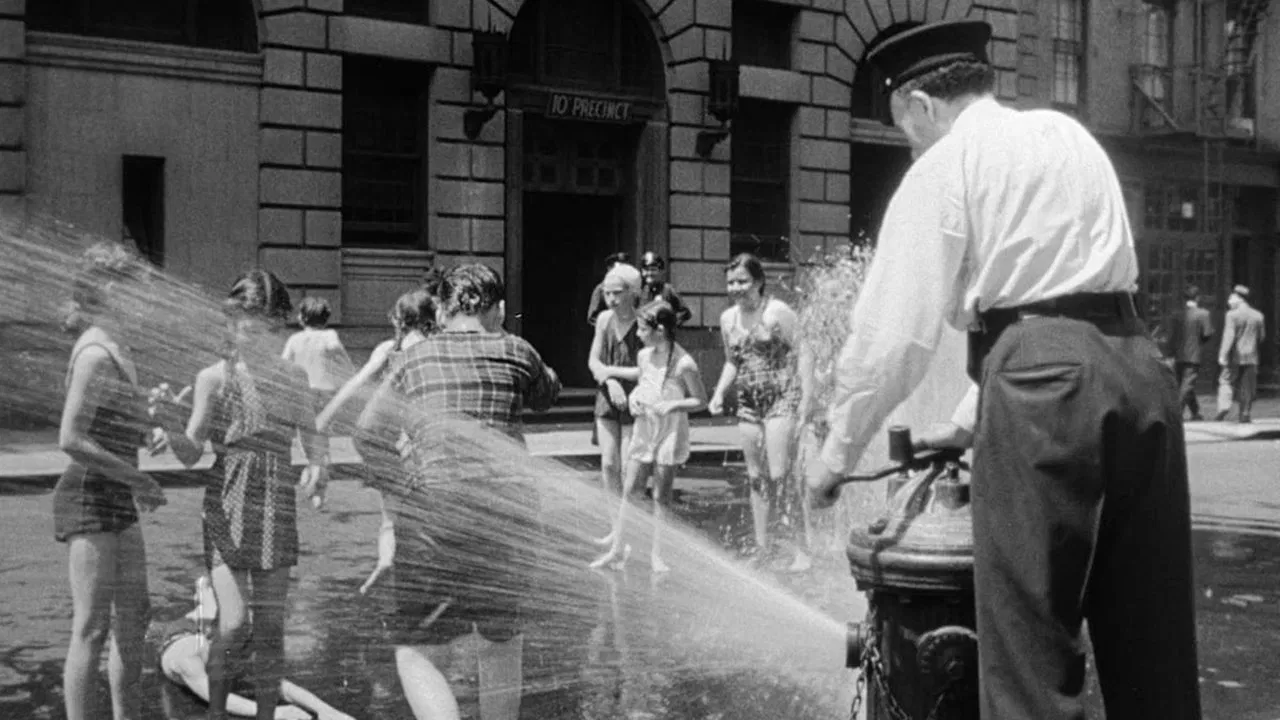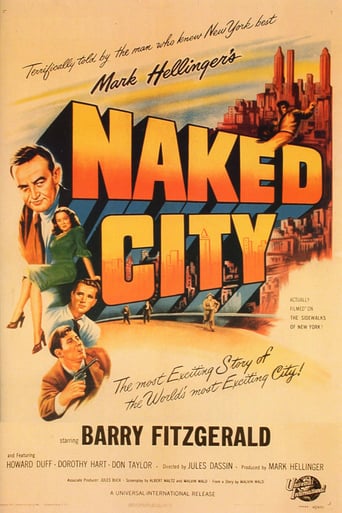

Good start, but then it gets ruined
... View MoreI really wanted to like this movie. I feel terribly cynical trashing it, and that's why I'm giving it a middling 5. Actually, I'm giving it a 5 because there were some superb performances.
... View MoreClever and entertaining enough to recommend even to members of the 1%
... View MoreThis is one of the few movies I've ever seen where the whole audience broke into spontaneous, loud applause a third of the way in.
... View MoreNew York cops unravel a murder. Very believable tale with lots of sociological comments.The most notable aspect is that the narrator tells the viewer who made the film--the director, the actors, the scriptwriters, etc., and the real inhabitants of the city. The narrator states an important fact--the entire film was shot outside the film studios: in New York, in the streets and in real apartments.The cinematography (the final sequence), the direction and the script are all praiseworthy, keeping the viewer interested right up to the end. A rare film in which the cops are smart!Structurally, very close to what Aristotle would have approved.
... View MoreWinner of two Oscars: Best Cinematography, Black-and-White for William H. Daniels, and Best Film Editing for Paul Weatherwax. Malvin Wald was also nominated for an Oscar for his screenplay.This docu-drama stars Barry Fitzgerald. I watched him the other night in The Quiet Man, and I remember him fondly from Going My Way, for which he got an Oscar.An interesting tidbit about Fitzgerald: There have been 11 actors nominated for two Oscars in the same year; most recently Cate Blanchett for Elizabeth: The Golden Age and for I'm Not There. Fitzgerald is the only actor who got two nominations for the same film. They gave the Best Actor award to Bing Crosby, and the Best Supporting Actor to Fitzgerald.They had a tendency to overact back then, but that is part of the charm of the movie.No fancy CSI, just old fashion police work; wearing out the shoe leather.
... View MoreThe narrator intones, "There are eight million stories in the naked city " as the film begins with scenes of the quiet city in the early hours after midnight. We are introduced to those who are working the third shift in a city that never sleeps. We know that we are not seeing a studio, for the "actors" – those who populate the great city of New York – are eventually observed in apartments, skyscrapers, factories, restaurants, coffee shops, parks, docks, and sidewalks. The city is hot in the summer. During the beginning narration, an unconscious blonde model is being murdered at the young age of 26 years. Within four hours, one of the two murderers kills the other and throws his body into the river. A few hours after that, the cleaning lady enters Miss Dexter's apartment, sees the body in a bathtub, and screams. Now our story takes hold. The police are quickly on the scene, and the newspapers follow. Before long the police examiner determines that the promiscuous woman's death was not by accident or suicide, but by homicide.Soon the lawmen discover that the dissolute woman was part of a jewel burglary ring that targeted the rich folks. Frank Niles, disreputable and a pathological liar, and Jean Dexter were part of the set-ups. Also a famous doctor is involved. In reality this film is a routine detective story. It involves the somewhat tedious but difficult – and sometimes dangerous – police work of investigation, of gathering information and piecing it all together. But the detectives and police are dedicated heroes who do their jobs with little complaint. It all comes down to a climax that involves an exciting city-wide dragnet for the arch-killer. Unfortunately for him, he is unable to board an overcrowded bus that would have taken him away from the targeted area. A panicked gunshot at a seeing-eye dog alerts police, and the ending occurs at the Williamsburg Bridge in the Lower East Side of Manhattan. Case closed.As for Jean Dexter, "her name, her face, her history were worth five cents a day for six days." Now, with the case over, the old newspapers lying in the streets are cleaned up by the city trash men. Dexter is soon forgotten by virtually all, for there are eight million other stories brewing. A very few, including Dexter's grief-stricken parents, will never forget. The next day another story will reach the headlines, and our police heroes will be ready to solve another crime.Alhtough Muldoon spearheads the investigation, he is assisted by Jimmy Halloran (Don Taylor); there are other detectives, like Constantino and Perelli, although they have lesser roles. The Irish brogue of Barry Fitzgerald (Det. Lt. Dan Muldoon) can be a bit overpowering, but the pint-sized detective does deliver his lines with knowledge and charm. And is he shrewd! Howard Duff plays sleaze Frank Niles, and Ted DeCorsia is a wicked Willie Garzah. The film's producer, Mark Hellinger, narrates.Shot on location on New York City streets in secret, and semi-documentary in style, the film is ground-breaking. It was obviously the inspiration of the later TV series, "Naked City" (1958-1963), and even "Dragnet" before that. The black and white photography is so good that the movie earned an Academy Award. Another award was won for film editing. While the old-time life of the city has changed, many of the police procedures seen are obviously in use today. If the plot seems standard or if the story appears boring at times, remember that detailed police procedure works the same way: constant probing, questioning, checking, and rechecking. Much less often does it consist of high speed chases and slam-bang shoot-outs. Who is the real hero of the story? Why the personality of the city of New York, of course!
... View MoreThe "city" is New York, and in particular, Manhattan. The film's plot begins during the middle of the night. Two men whose faces we cannot see kill a young woman in a bathtub. The rest of the story centers on a Manhattan cop, Lt. Dan Muldoon (Barry Fitzgerald), and his "homicide squad", as they try to solve the murder.The film is a little unusual for its time period in that most crimes in 1930s and 1940s crime films were solved by cerebral private detectives, like Sam Spade or Charlie Chan. Cops were peripheral, and portrayed as rather bumbling. But in "The Naked City", there is no private detective. It's the city police who, through laborious hard work, make efforts to solve the crime. The film is basically a police procedural.The story's underlying premise is not especially interesting. It's the plotting, showing the leg work of the cops that keep the film moving along, interspersed with some eccentric minor characters that create entertainment for viewers.What really hurts this film is the narration by its producer, Mark Hellinger. In voice over, he introduces viewers to the film; he gives us progress reports; he talks to the characters along the way. At one point he tells viewers: "The day's work is over now. People are on their way home. They're tired; they're hot; they're hungry. In the newspapers there's a new murder story." And then later, he tells us: "It's 7:30 in the evening now. It's been a great day on the Dexter case. Developments? None. New clues? None. Progress? None." That watch-along-with-Mark gimmick might have been "cute" in 1948. Today, it's just tacky.Probably the best element is the B&W cinematography. The nighttime scenes outdoors, with the high-contrast side lighting, really give the film a most pleasant noir look and feel. And daytime outdoor shots occur on location in Manhattan, giving us a sense of realism. Unaware they're in a film, real New Yorkers go about their business, as the film's characters walk, or chase other characters."The Naked City" isn't really a thriller or suspense film, though elements of those genres occur in some sequences. The film is mostly a police drama. The visuals look quite dated. The narration is super annoying. Acting is average. The main reason to watch is the visual realism of the Manhattan setting and the overall photographic achievement.
... View More